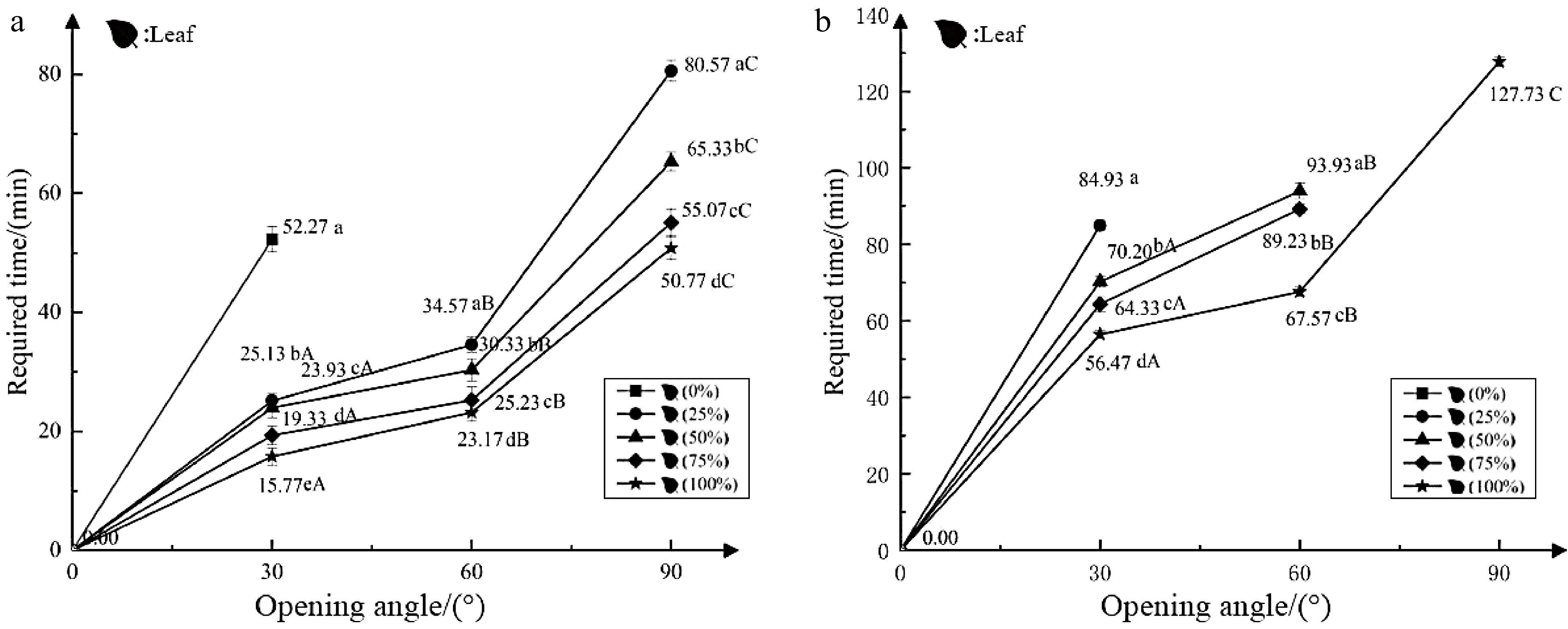-

Figure 1.
Different states of nyctinastic movement of O. triangularis ‘Purpurea’ leaves and flowers. Front view of leaves from different angles: (a) 0°; (b) 30°; (c) 60°; (d) 90°; side view of leaves from different angles: (e) 0°; (f) 30°; (g) 60°; (H) 90°; front view of flowers from different angles: (i) 0°; (j) 30°; (k) 60°; (l) 90°; side view of flowers from different angles: (m) 0°; (n) 30°; (o) 60°; (p) 90°.
-

Figure 2.
Effects of light on the nyctinastic movement of O. triangularis 'Purpurea'. (a) Light in the morning, closing leaves (flowers); (b) light in the evening, closing leaves (flowers). No polyline means the state does not meet the current standard in 150 min. The small letters indicate significant differences between spreading data at the same angle (P < 0.05); the capital letters indicate significant differences between data under the same processing state (P < 0.05).
-

Figure 3.
Effects of temperature on the nyctinastic movement of O. triangularis ‘Purpurea’. (a) Increasing temperature in darkness, closing leaves (flowers); (b) increasing temperature in darkness, opening leaves; (c) decreasing temperature in darkness, closing leaves (flowers); (d) increasing the same temperature in darkness, closing leaves (flowers); (e) continuous different temperatures, closing leaves (flowers).
-
Test Purpose Pre-treatment Leaf/flower state
after pre-treatmentTreatment Test 1 Effects of morning light Light: 100%, 8:00−22:00, Temperature: 20 °C Leaf: closed
Flower: closedLight on: 8:00, light intensity: 0, 25%, 50%, 75%, 100%, Test 2 Effects of night light Outdoor natural lights temperature 19.9 °C Leaf: closed
Flower: closedLight on 18:00, light intensity: 0, 25%, 50%, 75%, 100% Test 3 Effects of elevated temperature in the dark Light: 100%, 8:00−22:00, temperature 15 °C Leaf: closed
Flower: closedLight on: 8:00, temperatures: 15, 20, 25, 30, 35 °C Test 4 Effect of increasing temperature in the dark Outdoor natural lights
temperature. 15 °CLeaf: unfold
Flower: closedLight on: 8:00, temperatures: 15, 20, 25, 30, 35 °C Test 5 Effect of lowering the temperature Light: 100%, 8:00−22:00, temperature: 35 °C Leaf: closed
Flower: closedLight on: 8:00, temperatures: 15, 20, 25, 30, 35 °C Test 6 Effects of increasing same temperature Light: 100%, 8:00−22:00, temperature: 15, 20, 25, 30 °C Leaf: closed
Flower: closedLight on: 8:00, temperatures: increased by 5 °C from the original Test 7 Effect of successive
different temperaturesDark, temperature: 15, 20, 25, 30, 35 °C Leaf: closed
Flower: closedLight on 18:00, 100% light Test 8 continuous dark Outdoor natural lights
temperature 20 °CLeaf: closed
Flower: closedAt 18:00, give 20 °C dark treatment for 3 consecutive days Test 9 The effect of entering darkness At 8:00, light: 100%, temperature: 20 °C Leaf: unfold
Flower: unfoldDark treatment at 16:00, 18:00, 20:00, 22:00, and 24:00, respectively Temperature: 20 °C Table 1.
Experimental design.
-
Tissue Leaves Flowers Number of days Day 1 Day 2 Day 3 Day 1 Day 2 Day 3 Leaf start opening time 6:00 8:20 11:40 \ \ \ The time interval between leaf opening (h) \ 26.33 27.33 \ \ \ State at 150 min 30° 30° 30° 0° 0° 0° Leaf start closing time 9:10 13:00 15:00 \ \ \ Leaf complete closing time 11:30 15:00 20:30 \ \ \ Time of start close to full close (h) 2.33 2 5.5 Time of start open to full close (h) 5.5 6.67 8.83 \ \ Table 2.
Nyctinastic movement of leaves (flowers) under continuous darkness.
-
Opening state Time to enter dark conditions 16:00 18:00 20:00 22:00 24:00 Leaves Leaf start opening time 5:30 6:30 7:30 8:30 9:00 State at 150 min 30° 30° 30° 30° 30° Time from entering dark to starting open (h) 13.5 12.5 11.5 10.5 9 Flowers Leaf start opening time \ \ \ \ \ State at 150 min 0° 0° 0° 0° 0° Time from entering dark to starting open \ \ \ \ \ Table 3.
The effect of entering dark conditions at different times on the nyctinastic movement of leaves (flowers).
Figures
(3)
Tables
(3)